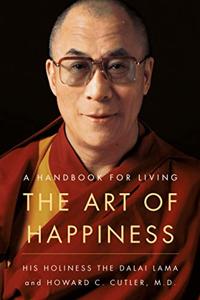
Want to learn the ideas in The Art Of Happiness better than ever? Read the world’s #1 book summary of The Art Of Happiness by Dalai Lama, Howard C. Cutler here.
Read a brief 1-Page Summary or watch video summaries curated by our expert team. Note: this book guide is not affiliated with or endorsed by the publisher or author, and we always encourage you to purchase and read the full book.
Video Summaries of The Art Of Happiness
We’ve scoured the Internet for the very best videos on The Art Of Happiness, from high-quality videos summaries to interviews or commentary by Dalai Lama, Howard C. Cutler.
1-Page Summary of The Art Of Happiness
Part I. The Purpose of Life
Chapter 1: The Right to Happiness
“The purpose of life is to seek happiness. Whether you believe in religion or not, we all are searching for something better in our lives. Therefore, the goal of life is to find happiness.” (13). This statement was made by the Dalai Lama at a conference he attended. Chapter one introduces what this book is about: The Art of Happiness.
Psychiatrist Howard Cutler followed the Dalai Lama around on this tour. Cutler, as well as many of his patients, believed that happiness was ill defined and ungraspable. The word happy is derived from luck or chance. His stance changed after spending time with the peace leader.
“When I say ‘training the mind,’ I’m not referring to just your intellect. Rather, it’s a combination of intellect and feelings that make up your mind. By practicing certain disciplines we can change our attitude and outlook on life.”
The Dalai Lama once said that the purpose of life is to seek happiness. After studying previous experiments, he found that unhappy people tend to be self-focused, withdrawn and antagonistic. On the other hand, happy people are more sociable and flexible; they can easily tolerate daily frustrations.
The Dalai Lama views happiness as a goal that people set for themselves and work towards achieving. This creates happiness in the process.
Chapter 2: The Sources of Happiness
Chapter 1 talks about how we can train our minds to be happier. Chapter 2 explains that we have a baseline level of happiness, and we may experience happiness or unhappiness depending on external events. For example, one woman retires at age 32 but is soon back to her normal level of happiness; another man gets diagnosed with HIV, which lowers his level of happiness but he later appreciates life more than before. These examples show us that even when things go wrong in our lives, they eventually return to their normal state and the baseline level stays the same (21).
The book explains how people compare themselves with others and within themselves. People who do this will be unhappy because they’re comparing their income, which doesn’t make them happy in the end. The Dalai Lama says that if we think about those who are less fortunate than us, then we can appreciate what we have (22-23). We are born into a certain state of mind about happiness, but it’s possible to change our outlook by being happier in each moment. For example, self-worth is having a source of affection and compassion for ourselves as well as dignity (32). In order to find happiness without finding material things, we need contentment. If something brings us pleasure or happiness without negative consequences when dealing with positive actions or objects then it should bring us satisfaction (28).
Chapter 3: Training the Mind for Happiness
The first step to controlling your mind is learning. You should analyze thoughts and emotions to determine if they’re helpful or harmful. If you know something might tempt you, avoid it. Positive desires are good.
Chapter 4: Reclaiming our Innate State of Happiness
Everyone is born with a natural ability to be happy. Happiness can be found through love, affection, closeness and compassion. Not only do humans have the capability of being happy, but also Buddhism says that we all have an inner gentleness in us. The Dalai Lama supports this theory by mentioning Buddha nature (the Buddhist doctrine), which means that gentleness is not only affected by religion but everyday life as well. With gentleness comes aggression; people argue that aggression is the dominant behavior for human beings because they’re frustrated at not getting what they want: love and affection. However, overall our fundamental nature is gentleness rather than aggression when you look at it more closely and deeply into ourselves. This suggests the idea that humans are “programmed with the capacity and purpose of bringing pleasure and joy to others”. Therefore happiness can be reached by keeping peace with others through meditation or community service so one’s self becomes more peaceful as well creating a positive atmosphere around oneself making it easier to find peace within oneself giving your life meaning which leads to overall happiness






